Well bratwurst, obviously! What comes to mind when you think of food in Thüringen? I presume most of you answered that question with that answer. As part of the Kulinarik project with my clients the Thüringer Tourismus GmbH I have the incredible of opportunity of traveling around Thüringen on an one-of-a-kind adventure. On this path of food I get to meet some pretty awesome professionals, talk and learn about traditional Thüringian dishes and the history, photograph and then create a recipe with those typical flavors.
We start the journey with a classic! The Thüringer Rostbratwurst is probably the most iconic specialty, its fame reaching not only across Germany but also around the world. It goes back to ancient traditions, where some sources date the oldest recipe found back to 1404. The Rostbratwurst is made mainly of pork from either the belly or the shoulder and usually veal or beef is also added to the finely chopped mixture. This is seasoned with a delicious blend of spices and herbs, like garlic, cumin, coriander and marjoram and then packed into hog or sheep casings.
Fanatics and connoisseurs often have several tricks when it comes to barbecuing the Rostbratwurst. Everything ranging from basting the sausages in beer or greasing the grill with pork belly fat to soaking in water, is all common practice. Despite the myriad methods to grill these sausages, the most authentic way to eat it is in a fresh white bread roll with a slathering of hot mustard.
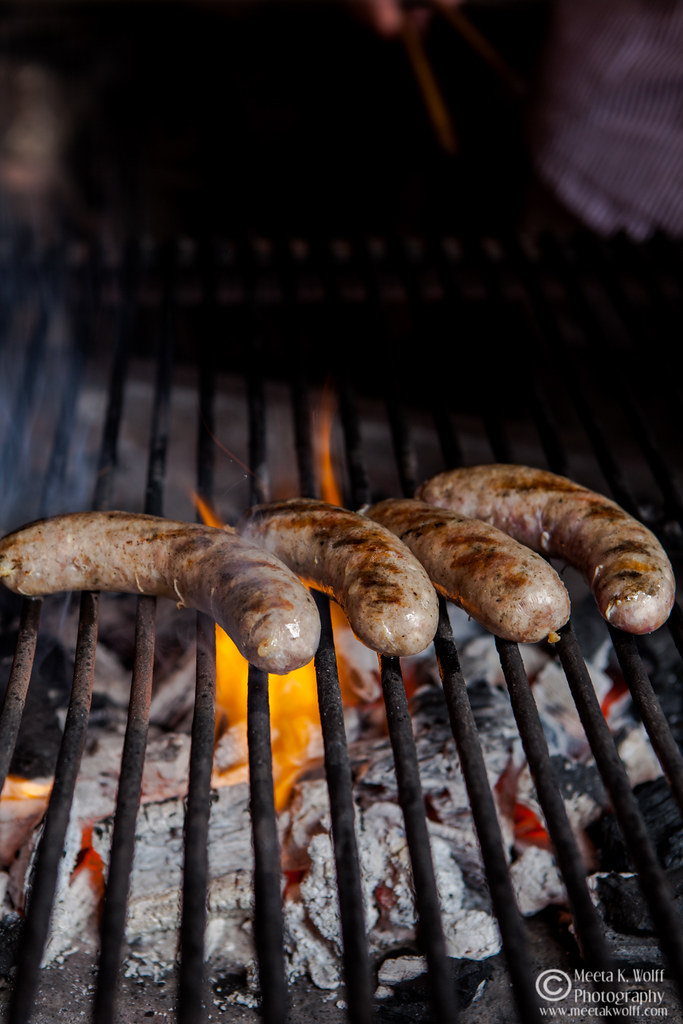
I’ve been living in Weimar for 10 years and as a person who loves to cook and experiment, the good old bratwurst has been a subject to many tests in my kitchen. While a white roll and hot mustard soothes the immediate bratwurst cravings, I find it to be a very versatile product and enjoy serving it in many untraditional ways.
So imagine my elation at having a chance to taste and test a slightly different kind of bratwurst made right here in Thüringen. In search of this bratwurst we travelled to the charming rural area of Eichfeld, where at the foot of one of central Germany’s most beautiful castle ruins – Burg Handstein, lies the picturesque town of Bornhagen. Here, in this unobtrusive town we are warmly welcomed to the Klausenhof – where the Röhrig family has been running this historic tavern since the early 90s.
There is a fascinating appeal to the Klausenhof, with its impressive rooms and knightly dining areas. A tourist guest-house since the early 19th century, one sees and feels the intricate love for detail the Röhrig family has invested in renovating the building and the furniture. The Klausenhof is in the hands of Martin Röhrig, who took over from his father in 2008. As a trained chef, Martin has had an impressive career, including working under renowned star chefs like Johann Laffler and Marcello Fabri. After a 6 month stay in Melbourne working for Scott Pickett, Martin returned to Bornhagen to run the family business.
The passion for food and what he does is unmistakable, Martin rises to his calling allowing innovative ideas to flow into the kitchen, but still keeping the dishes authentic. The menu boasts of hearty dishes using seasonal products and the large array of herbs from their vast herb terraces. One dish, however, rises above the rest – the wild game bratwurst. This is what I have come for.
Herr Dode, the butcher himself, shows me into the kitchen where he will prepare fresh bratwurst for me. I am honored and feel an affable affection for this big lug of a guy, who patiently answers questions and allows me to take several pictures. While he shyly explains that the bratwursts are made of wild boar, pork meat, lots of herbs like thyme and spices like ground coriander and his secret ingredient, he pours a good glug of sherry into the sausage meat.
Martin fires up the charcoal barbeque and the wild boar bratwurst fresh out of the kitchen sizzle sensuously on the grill. At the Klausenhof they are served with a generous portion of sauerkraut, Thüringer Klöße, a crunchy salad and a variety of the homemade sauces, which come in all sorts of flavors from a powerful BBQ to a Cumberland sauce. Of course, one can get side of hot mustard with it too.
For my own interpretation I wanted to go a different route than the traditional way bratwurst is served and consumed. Deriving from the fundamental idea of bread and cabbage, and incorporating the flavors from the herbs and spices found in the bratwurst, I create a tasteful dish worthy of any fancy dinner-table or a gathering with friends.
A flammkuchen using wholewheat flour makes the basis for the creation. Red cabbage, slowly caramelized to impart the light flavors, is infused with thyme, juniper berries, cumin seeds and cinnamon to bring a warming aromatic essence to the cabbage. Piment d'Espelette brings a slight piquancy balancing the sweetness from the pear and caramelized cabbage. The zest and juice of an orange rounds off the flavors perfectly. The wild game bratwurst itself is striped off its skin and the sausage meat is sautéed with thyme and garlic then scattered over the cabbage and flammkuchen base. Finally, the flammkuchen is baked till the base is crispy of a hot pizza stone in the oven.
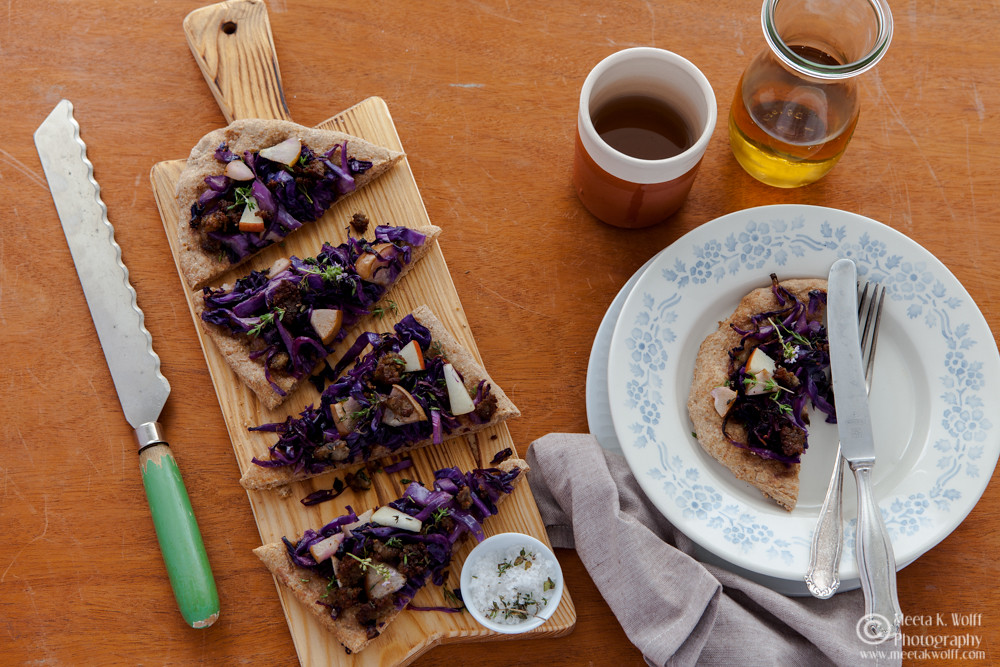
Recipe: Whole-wheat Flammkuchen with Bratwürst on Caramelized Cabbage and Pear
By Meeta K. WolffPrep Time:
Total Time:
Makes: 4 Flammkuchen
Ingredients
Whole-wheat flammkuchen base- 300g whole-wheat flour
- 50ml olive oil
- Pinch of salt
- ¼ teaspoon dry yeast
- 200ml water
Caramelized cabbage with pear
- ½ red cabbage – finely shredded
- 100g butter
- 50g muscovado sugar
- 2 oranges – zest of 1, juice of both
- 2 pears, cubed
- 3-4 juniper berries
- ½ teaspoon cumin seeds
- ½ cinnamon stick
- 3-4 sprigs of thyme
- Pinch of Piment d'Espelette (alternatively you can use cayenne pepper)
Wild Game Bratwürst
- 1-2 tablespoons olive oil (depends on how fatty the bratwursts are)
- 2-3 bratwurst (preferably wild game but a good quality traditional bratwurst will also work)
- 1 garlic clove (thinly sliced)
- 3-4 sprigs of thyme
Method
- For the flammkuchen base: add all the ingredients in a stand mixer fitted with a dough hook. Knead for 8-10 minutes until you have a smooth pliable dough. Cover the bowl and allow to rest for 30 minutes. Make the cabbage while dough is resting. Heat a pizza stone (alternatively you can heat a baking tray) in the oven at 220 degrees C. After the resting period divide the dough in 4 pieces, rolling each one into a smooth ball. With a rolling pin roll 4 small oval bases. Cover with a damp cloth and allow to rest for another 30 minutes.
- For the cabbage and pear: melt the butter in a large non-stick pan then sprinkle the sugar and allow the sugar to melt. Add the cabbage and toss several times to coat with the buttery-sugary sauce. On gentle heat allow the cabbage to caramelize for 8-10 minutes. Add the spices and herbs and cook for another 3-5 minutes, then pour the orange juice and the zest, toss well allow simmer until flavors have infused. Finally add the pear cubes and heat through. Set aside to cool.
- For the bratwürst: heat the oil in a non-stick frying pan. Add the garlic and thyme and infuse the oil on a medium heat for 1-2 minutes. Sauté the sausage meat until just turning golden – the meat will cook further in the oven so you need to make sure it does not overcook in the pan.
- To assembly the flammkuchen divide the cabbage mixture over the 4 flammkuchen and spread the bratwurst meat over each flammkuchen. Bake the flammkuchen, 2 at a time on the pizza stone for 10-12 minutes until the base is crispy and golden.
The flammkuchen would be perfect with a red wine with fruity berry-like flavors like a Malbec or a chilled white wine such as a Riesling with citrus-like flavors.
Verdict
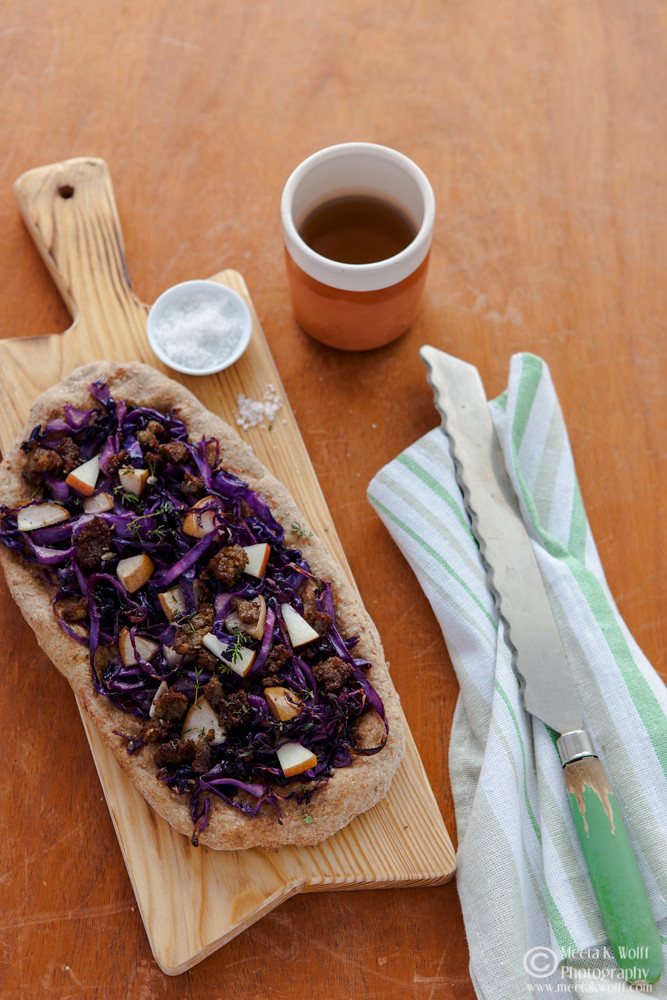
Flammkuchen, or as the French call them Tarte flambée, literally translated means “Flame Cake,” and it is presumed that this comes from its original heritage as something put in to test the heat of the oven before baking bread and other foods. In Germany the Flammkuchen is most popular just after the grape harvest, when the new wine, known as Federweißer, appears on the market. Restaurants offer great specials with both the Federweißer and Flammkuchen to their guests, who in turn come is hoards to enjoy the delicious combination. This is the perfect time for this light crispy thin pizza like dish. Fiery, robust and with a slight sweet note this is an awesome dinner with friends.
Stay tuned for more of my Kulinarik travels next month. You can see the original story on the Thüringen Entdecken food blog “Herzenwärmer”.
The Bratwürst trailer for was shot recently as I went on tour with the team. Enjoy!
The props for the flammkuchen images are from Depositario, handmade wooden bards, plates and glasses - some amazing stuff. The shop is run by 2 lovely friends Susana and André who were a part of a food photography and styling workshop in Somerset. Both are wonderfully talented so please do check out their items!
All photographs and written content on What's For Lunch, Honey? © 2006-2014 Meeta Khurana Wolff unless otherwise indicated. | All rights reserved | Please Ask First



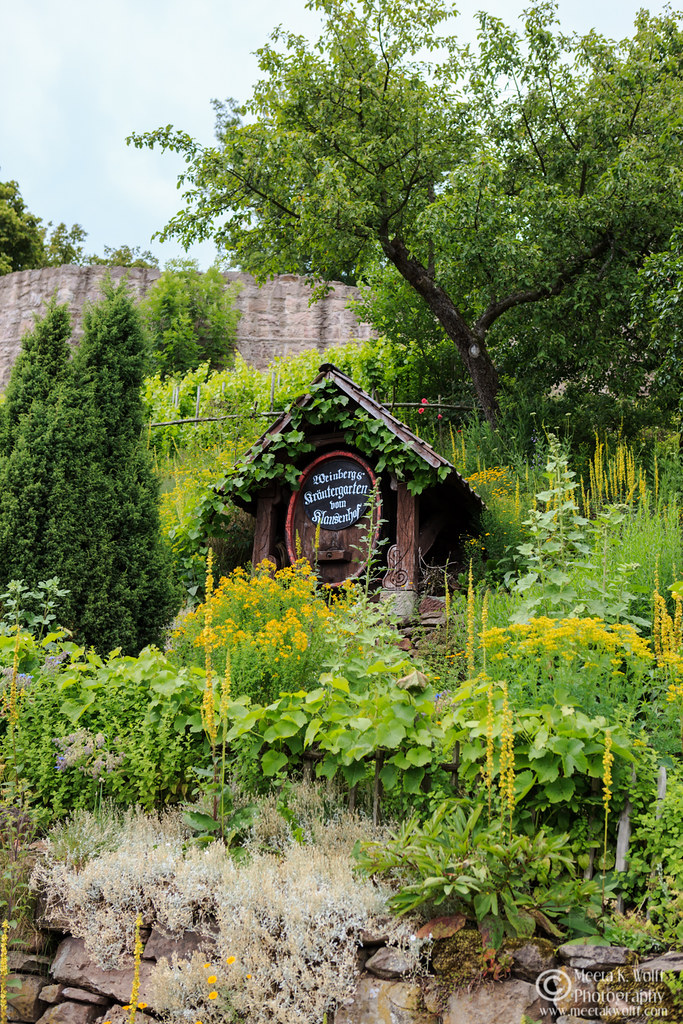
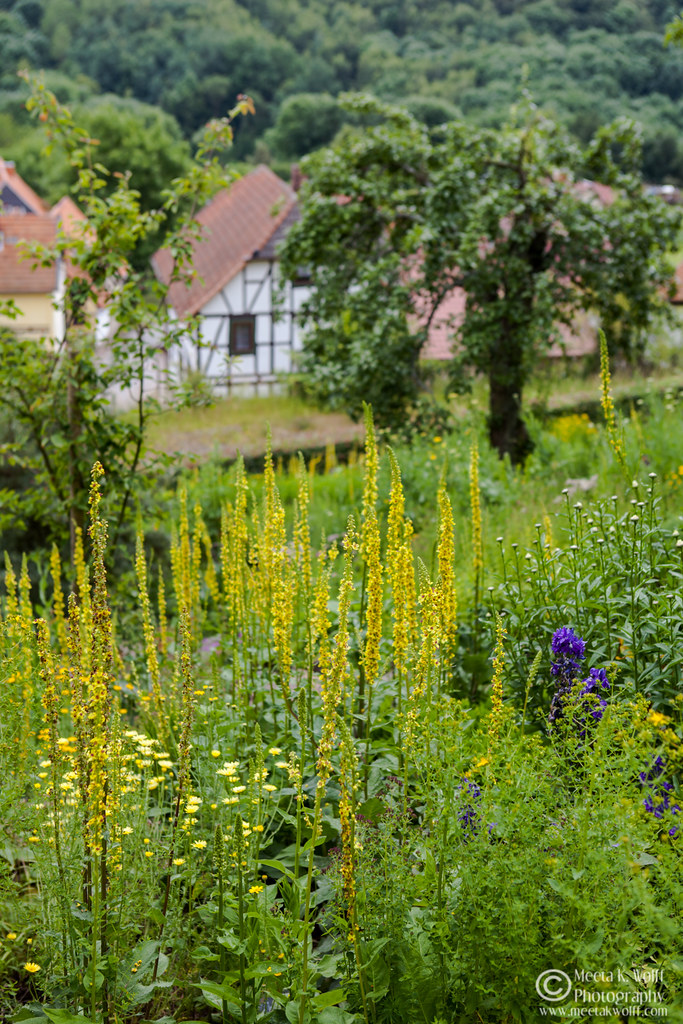

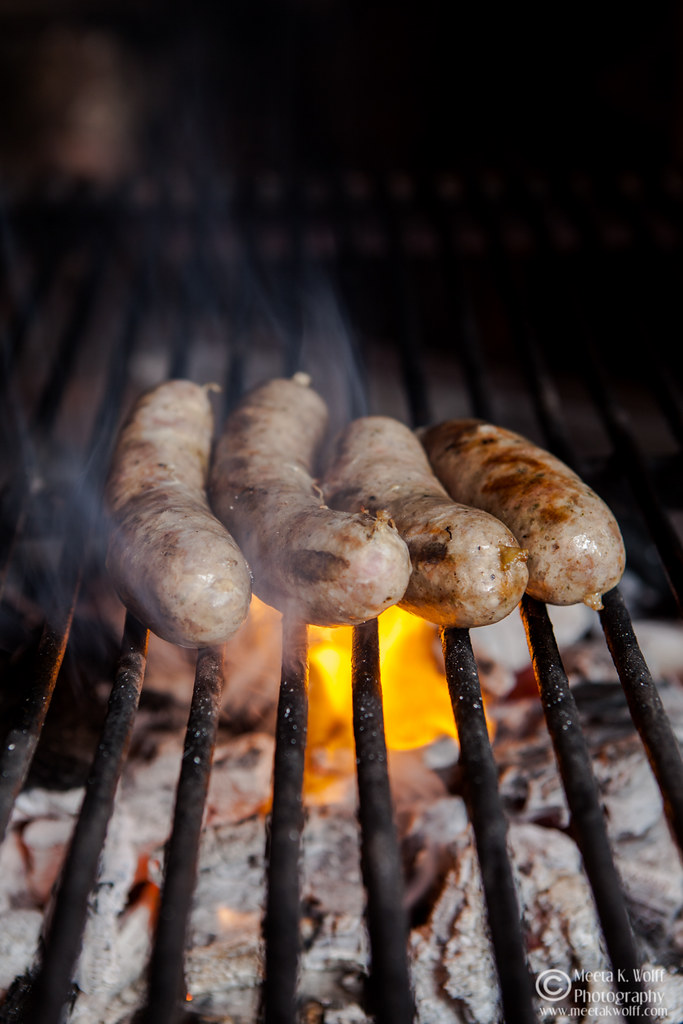
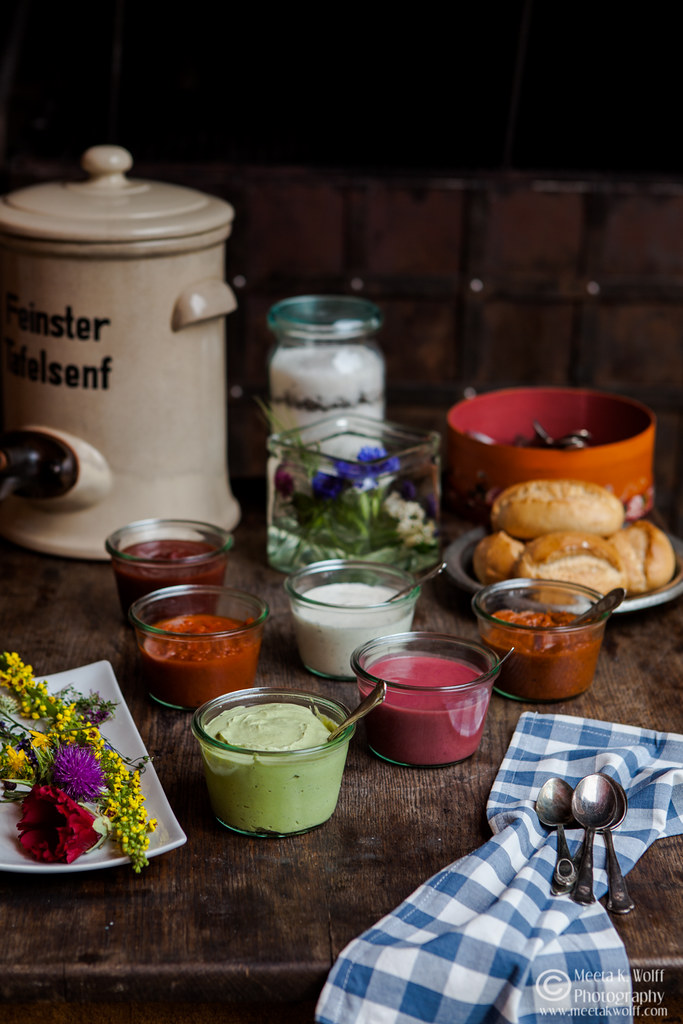

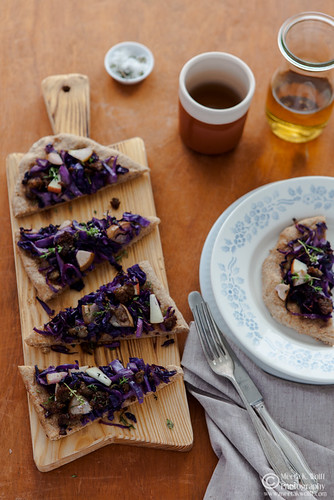
Wunderbar und tolle Fotos! Auf unserer Fahrt nach Berlin ist in Thüringen die Thüringer Rostbratwurst ein Muss! Und hier gibt es in fast jeder Wirtschaft Flammkuchen, aber keinen mit Bratwurst, interessante Variante!
ReplyDeleteLG
Tinka
Liebe Tinka, Vielen Dank! Ja einfach etwas "out of the box" gedacht und 2 Libligs Gerichte zusammen gebract!
DeleteSuch beautiful colors! Love learning more about this recipe's origins too.
ReplyDeleteThank you Liz! There dishes in this region have rich and colorful historic origins for sure. It's absolutely a pleasure for me to be working on this project!
DeleteThe Thüringer Rostbratwurst is really delicious and I love Flammkuchen. Your recipe is therefore really a perfect match. Great Pictures :)
ReplyDeleteThank you! I hope you will try it and let me know what you think!
DeleteGreat pictures and a thoroughly laid down recipe. Have already bookmarked it to be trying over the weekend.
ReplyDeleteFoodDrifter
Great - I hope you will let me know your thoughts and how it turned out. I absolutely loved the flavors paired with the rustic crust here!
DeleteInteresting! I recently moved to Leipzig. I don't eat meat but I would definitely try these with tofu bratwurst :D
ReplyDeleteHope it works. I am partial to my traditional Thüringian Rostbrawurst though :)
DeleteDelicious layers of flavors here :)
ReplyDeleteYes Kiran - it was!
Delete